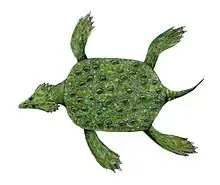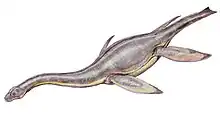| Leptocleidus Temporal range: Early Cretaceous, | |
|---|---|
 | |
| Life restoration of L. capensis | |
| Scientific classification | |
| Domain: | Eukaryota |
| Kingdom: | Animalia |
| Phylum: | Chordata |
| Class: | Reptilia |
| Superorder: | †Sauropterygia |
| Order: | †Plesiosauria |
| Family: | †Leptocleididae |
| Genus: | †Leptocleidus Andrews, 1922 |
| Species | |
| |
| Synonyms | |
| |
Leptocleidus is an extinct genus of plesiosaur,[1] belonging to the family Leptocleididae.[2] It was a small plesiosaur, measuring only up to 3 m (9.8 ft).[3]
Discovery
In short, the term Leptocleidus means "slender clavicle". It comes from a merge of the Greek words λεπτοσ, meaning "slender" and κλειδ (also spelled κλεισ) meaning clavicle.
Leptocleidus is known from the following sediments:
- L. capensis is known from the Sundays River Formation (upper Valanginian age), Cape Province, South Africa.[3]
- L. clemai found near Kalbarri in the Carnarvon Basin (Hauterivian-Barremian age) Western Australia.
- L. superstes is known from the Upper Weald Clay (Barremian age), Sussex, England.
A specimen from the Vectis Formation (lower Aptian age), Isle of Wight, found in 1995 and seen as a "Leptocleidus sp.", was named as a separate genus Vectocleidus in 2012.
Description
With large clavicles and interclavicle and small scapulae, Leptocleidus resembled the Early Jurassic Rhomaleosaurus and members of the Cretaceous family, Polycotylidae. The animal had 21 teeth on either side of its maxilla and approximately 35 teeth on each side of the mandible. The Leptocleidus' triangle-shaped skull had a crest running from a ridge on the end of the nose to the nasal region. Differing from pliosaurids, Leptocleidus had single-headed cervical ribs and a deep depression in the centra of the neck vertebrae.[3]
Leptocleidus, unlike many plesiosaurs, lived in shallow lagoons and likely visited brackish and fresh water systems (such as the mouths of large rivers). This led Arthur Richard Ivor Cruickshank to infer that this movement to fresh water was an attempt to flee larger plesiosaurs and pliosaurs. Most species are known from The British Isles but L. capensis was discovered in Cape Province, South Africa.[3]
Classification

Cladogram based on Ketchum and Benson (2011):[4]
| Leptocleididae |
| ||||||||||||||||||||||||
See also
References
- ↑ Ketchum, H. F.; Benson, R. B. J. (2010). "Global interrelationships of Plesiosauria (Reptilia, Sauropterygia) and the pivotal role of taxon sampling in determining the outcome of phylogenetic analyses". Biological Reviews. 85 (2): 361–392. doi:10.1111/j.1469-185X.2009.00107.x. PMID 20002391. S2CID 12193439.
- ↑ Smith AS, Dyke GJ. 2008. The skull of the giant predatory pliosaur Rhomaleosaurus cramptoni: implications for plesiosaur phylogenetics. Naturwissenschaften e-published 2008.
- 1 2 3 4 Cruikshank A. R. I. (1997). "A lower Cretaceous Pliosauroid from South Africa". Annals of the South African Museum. 105: 206–226.
- ↑ Hilary F. Ketchum; Roger B. J. Benson (2011). "A new pliosaurid (Sauropterygia, Plesiosauria) from the Oxford Clay Formation (Middle Jurassic, Callovian) of England: evidence for a gracile, longirostrine grade of Early-Middle Jurassic pliosaurids". Special Papers in Palaeontology. 86: 109–129.
Further reading
- O'Keefe F. R. (2001). "A cladistic analysis and taxonomic revision of the Plesiosauria (Reptilia: Sauropterygia)". Acta Zoologica Fennica. 213: 1–63.







.png.webp)